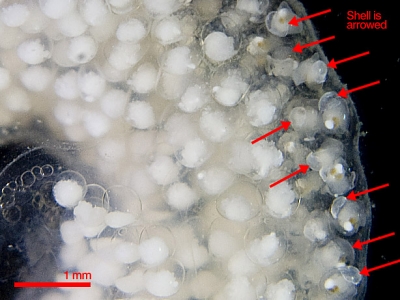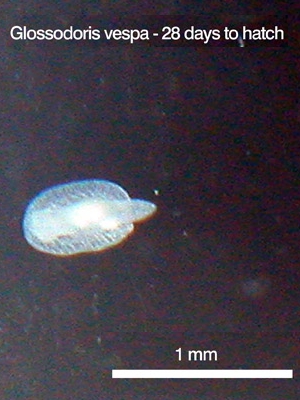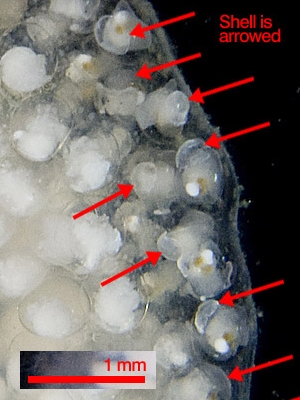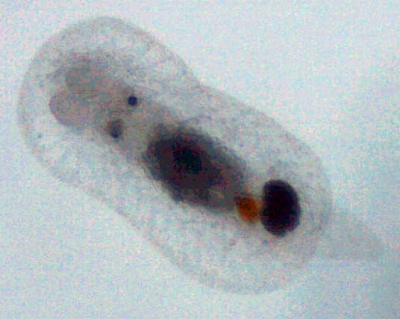Glossodoris vespa hatching today
February 8, 2008
From: Gary Cobb

Hi Bill and everyone!
Well after 28 days the developing embryos are now crawling around [7 December 2007]. There are some interesting bits to tell. I have noticed that all along the yolks and embryos were always at the bottom of the egg capsule probably because of gravity. After two weeks I noticed the embryos were all sitting up with velar lobes facing up. On an earlier drawing I sent you 'C' was indeed the shell which was on the bottom of the embryo. The little nudibranchs were born with 2 rhinophores. The mantle was transparent and appeared to have spicules. Maybe you can help with ID of the inner parts. The eye spots are very prominent and so is the beautiful tail!
The shells were left in the mass after the animal departed. They appear to be a semispherical cap. Do you think the embryos were facing up because of the weight of the shell?
I also think that with this species the reason it has a very restricted geographic range is because the egg mass is laid on the food source and the animal hatches directly and starts to feed...no need to drift for miles!
Locality: Adults-Old Woman Island, Mooloolaba, Sunshine Coast, Adults 14 m, Queensland, Australia, Pacific Ocean, 07 December 2007, Jar-kitchen. Length: Infants under 1 mm. Photographer: Gary Cobb.
Thanks
Gary Cobb (Dad)
gary@nudibranch.com.au



Dear Gary,
Thanks for this great series of observations on the development of Glossodoris vespa. I am sorry I wasn't able to post them immediately but they are a very valuable record. Concening your question about whether the weight of the eggs affected the way the embryos were arranged in the egg capsule I think it is probably the weight of the viscera and the current caused by the ciliated velar lobes which had more affect on the way the embryos were sitting. I must admit from my experience the embryos tend to revolve a lot in the capsules, but as direct developers reach hatching time they lose the velar lobes and get a bit big for moving in their capsule.
As a general rule I think we can say direct developers have a restricted geographic range but as I discussed earlier [message #21049] there are exceptions.
Best wishes,
Bill Rudman
Related messages
-
More feeding pics of Glossodoris vespa
From: David Mullins, December 11, 2008 -
Glossodoris vespa feeding
From: Gary Cobb, December 11, 2008 -
Glossodoris vespa eggs - progress report
From: Gary Cobb, December 11, 2007 -
Glossodoris vespa eggs at 10 days old
From: Gary Cobb, November 21, 2007 -
Re: Egg mass of Glossodoris vespa
From: Gary Cobb, November 20, 2007 -
Egg mass of Glossodoris vespa
From: Gary Cobb, November 10, 2007 -
Re: Glossodoris vespa endemic to sthn Queensland
From: David Mullins, October 31, 2007 -
Glossodoris vespa endemic to southern Queensland, Austr
From: Gary Cobb, July 4, 2007 -
Glossodoris from Mooloolaba
From: Wayne Ellis, May 26, 1998
